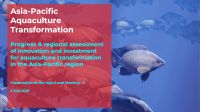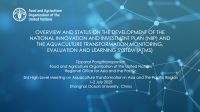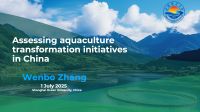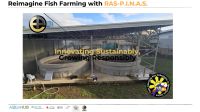This presentation by Eduardo Leaño, Director General of NACA, provides a background and introduction to the 3rd High-Level Meeting on Aquaculture Transformation in the Asia-Pacific Region (HLM-3).
The region accounts for around 90% of global aquaculture production but faces mounting challenges including resource scarcity, environmental pressures, climate change, and shifting global dynamics. Addressing these requires a strategic shift driven by innovation, investment, and stronger partnerships to build more efficient, inclusive, resilient, and sustainable aquatic food systems.
HLM-3 builds on the outcomes of previous high-level meetings and the Aquaculture Transformation White Paper, with a focus on national innovation and investment plans, regional collaboration, and implementation efforts to achieve transformation by 2030.
This video by Mike Phillips, CEO of FutureFish, explores the current state of aquaculture innovation and investment across the Asia-Pacific region. Technology innovation is advancing, especially for higher-value species, but challenges remain in scaling inclusive value chains and building climate resilience. Despite growth in private investment, significant financing gaps persist—particularly for SMEs and smallholders, who make up 90% of the sector. National policies, governance, and regulatory environments strongly influence the adoption and scaling of innovations.
The presentation highlights the importance of partnerships, innovation hubs, and better alignment between financing and transformation priorities to achieve sustainable and inclusive aquaculture development.
Development of National Innovation & Investment Plans & Aquaculture transformation monitoring system
This video by Tipparat Pongthanapanich, FAO, provides an overview of the development of National Innovation and Investment Plans (NIIPs) and the regional Aquaculture Transformation Monitoring, Evaluation and Learning System (ATMS). NIIPs aim to guide each country's strategic priorities for innovation and investment in aquaculture through 2030, aligned with the regional transformation vision. ATMS will support regional progress tracking and knowledge sharing.
An FAO-led technical cooperation project project is supporting the pilot development of NIIPs and ATMS in four countries - India, Thailand, Viet Nam, and the Philippines - with a view to wider regional application. Key components include strategic visioning, policy alignment, project formulation, and robust monitoring systems to drive inclusive, sustainable aquaculture development.
This video by Wenbo Zhang, Shanghai Ocean University, presents an overview of China’s aquaculture transformation journey as part of the broader “Blue Revolution.” It highlights trends in global aquatic animal production and outlines key challenges such as land use changes and environmental pressures.
The presentation details a series of national policies and strategies introduced since 2019 to promote green, healthy, and high-quality aquaculture development ranging from pond standardisation and deep-sea farming to innovation-driven investment and value chain upgrading. It also reviews recent actions supporting ecological farming, wastewater treatment, reduced chemical use, and improved germplasm resources, and introduces efforts to assess the impact of these transformation initiatives across the sector.
This presentation by Elisa Claire Sy of E-Primate, showcases how RAS-P.I.N.A.S - a closed-loop, water-efficient technology - enables high-density, land-based fish farming using biofiltration, aeration, and mechanical treatment strategies. Discover how RAS conserves water and land, minimises disease risk, and offers flexibility in farm siting, while recognising the trade-offs of energy demands and infrastructure costs. Learn why RAS is gaining momentum as a key innovation in Asia's sustainable aquaculture future.




